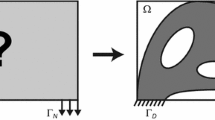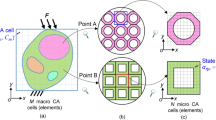Abstract
Topology optimization on a unit cell is a common technique to improve the fundamental frequencies of periodic cellular solid structures. During this procedure, the effective properties of cellular solids are primarily computed by the homogenization method. This homogenization method is based on the classic continuum theory under the assumption that the unit cell is infinitely small. Hence, this classic strategy is inadequate to interpret the size dependence of the optimal results. The aim of this study was to describe and examine size dependence in relation to the topology design of the unit cell to achieve maximization of the structural fundamental frequencies. For this purpose, we determined the effective properties of the cellular solids and constructed the optimization formulation based on the couple-stress theory rather than the classic theory. A modified bound formulation of the objective and constraint functions was used to avoid the non-differentiability of repeated frequencies. Although the existing theory does not reflect size dependence, our optimization formulation was able to identify the size dependence of both the microstructural topologies and the fundamental frequencies. The size-dependent results are achieved by varying of the mechanisms to achieve the maximal fundamental frequencies in response to cell size variation. The present formulation is suitable for the unit cell design of cellular solid structures that possess local dimensions comparable to the cell size, and this novel formulation has expanded the application scope of the classic microstructural design problem for periodic materials.











Similar content being viewed by others
References
Anderson WB, Lakes RS (1994) Size effects due to Cosserat elasticity and surface damage in closed-cell polymethacrylimide foam. J Mater Sci 29:6413–6419
Bendsøe MP (1989) Optimal shape design as a material distribution problem. Struct Multidiscip Optim 1:193–202
Bendsøe MP, Sigmund O (2003) Topology optimization: theory, methods and applications. Springer, Berlin
Bigoni D, Drugan WJ (2007) Analytical derivation of Cosserat moduli via homogenization of heterogeneous elastic materials. J Appl Mech Trans ASME 74:741–753
Bouyge F, Jasiuk I, Boccara S et al (2002) A micromechanically based couple-stress model of an elastic orthotropic two-phase composite. Eur J Mech A/Solids 21:465–481
Bruggi M, Taliercio A (2012) Maximization of the fundamental eigenfrequency of micropolar solids through topology optimization. Struct Multidiscip Optim 46:549–560
Bruns TE, Tortorelli DA (2001) Topology optimization of non-linear elastic structures and compliant mechanisms. Comput Methods Appl Mech Eng 190:3443–3459
Cadman JE, Zhou S, Chen Y et al (2013) On design of multi-functional microstructural materials. J Mater Sci 48:51–66
Chen W, Xia L, Yang J et al (2018) Optimal microstructures of elastoplastic cellular materials under various macroscopic strains. Mech Mater 118:120–132
Clarke FH (1990) Optimization and nonsmooth analysis. Society for Industrial and Applied Mathematics, Philadelphia
Dai GM, Zhang WH (2008) Size effects of basic cell in static analysis of sandwich beams. Int J Solids Struct 45:2512–2533
de Borst R, Sluys LJ (1991) Localisation in a Cosserat continuum under static and dynamic loading conditions. Comput Methods Appl Mech Eng 90:805–827
Deshpande VS, Fleck NA, Ashby MF (2001) Effective properties of the octet-truss lattice material. J Mech Phys Solids 49:1747–1769
Du J, Olhoff N (2007) Topological design of freely vibrating continuum structures for maximum values of simple and multiple eigenfrequencies and frequency gaps. Struct Multidiscip Optim 34:91–110
Du J, Sun C (2017) Reliability-based vibro-acoustic microstructural topology optimization. Struct Multidiscip Optim 55:1195–1215
Du J, Yang R (2015) Vibro-acoustic design of plate using bi-material microstructural topology optimization. J Mech Sci Technol 29:1413–1419
Eringen AC (1999) Microcontinuum field theories vol. 1. Springer, New York
Gao J, Li H, Gao L et al (2018) Topological shape optimization of 3D micro-structured materials using energy-based homogenization method. Adv Eng Softw 116:89–102
Hassani B, Hinton E (1999) Homogenization and structural topology optimization. Springer, London
Huang X, Xie YM (2008) Optimal design of periodic structures using evolutionary topology optimization. Struct Multidiscip Optim 36:597–606
Liu S, Su W (2009) Effective couple-stress continuum model of cellular solids and size effects analysis. Int J Solids Struct 46:2787–2799
Liu S, Su W (2010) Topology optimization of couple-stress material structures. Struct Multidiscip Optim 40:319–327
Mindlin RD (1963) Influence of couple-stresses on stress concentrations. Exp Mech 3:1–7
Neves MM, Rodrigues H, Guedes JM (2000) Optimal design of periodic linear elastic microstructures. Comput Struct 76:421–429
Niu B, Yan J, Cheng G (2009) Optimum structure with homogeneous optimum cellular material for maximum fundamental frequency. Struct Multidiscip Optim 39:115–132
Olhoff N (1989) Multicriterion structural optimization via bound formulation and mathematical programming. Struct Optim 1:11–17
Onck PR, Andrews EW, Gibson LJ (2001) Size effects in ductile cellular solids. Part I: Modeling. Int J Mech Sci 43:681–699
Osanov M, Guest JK (2016) Topology optimization for architected materials design. Annu Rev Mater Res 46:211–233
Rodrigues HC, Guedes JM, Bendsøe MP (1995) Necessary conditions for optimal design of structures with a nonsmooth eigenvalue based criterion. Struct Optim 9:52–56
Rovati M, Veber D (2007) Optimal topologies for micropolar solids. Struct Multidiscip Optim 33:47–59
Rozvany GIN, Zhou M, Birker T (1992) Generalized shape optimization without homogenization. Struct Multidiscip Optim 4:250–252
Seyranian AP, Lund E, Olhoff N (1994) Multiple eigenvalues in structural optimization problems. Struct Multidiscip Optim 8:207–227
Sigmund O (1994a) Design of material structures using topology optimization. Department of Solid Mechanics. Technical University of Denmark
Sigmund O (1994b) Materials with prescribed constitutive parameters: an inverse homogenization problem. Int J Solids Struct 31:2313–2329
Su W, Liu S (2010) Size-dependent optimal microstructure design based on couple-stress theory. Struct Multidiscip Optim 42:243–254
Su W, Liu S (2014) Vibration analysis of periodic cellular solids based on an effective couple-stress continuum model. Int J Solids Struct 51:2676–2686
Su W, Liu S (2016) Topology design for maximization of fundamental frequency of couple-stress continuum. Struct Multidiscip Optim 53:395–408
Svanberg K (1987) The method of moving asymptotes- a new method for structural optimization. Int J Numer Methods Eng 24:359–373
Tekoglu C, Onck PR (2008) Size effects in two-dimensional Voronoi foams: a comparison between generalized continua and discrete models. J Mech Phys Solids 56:3541–3564
Thomsen CR, Wang F, Sigmund O (2018) Buckling strength topology optimization of 2D periodic materials based on linearized bifurcation analysis. Comput Methods Appl Mech Eng 339:115–136
Tsai TD, Cheng CC (2013) Structural design for desired eigenfrequencies and mode shapes using topology optimization. Struct Multidiscip Optim 47:673–686
Veber D, Taliercio A (2012) Topology optimization of three-dimensional non-centrosymmetric micropolar bodies. Struct Multidiscip Optim 45:575–587
Zhang W, Sun S (2006) Scale-related topology optimization of cellular materials and structures. Int J Numer Methods Eng 68:993–1011
Acknowledgments
The authors acknowledge Professor Krister Svanberg for his kind providing of the MMA codes.
Funding
This study has been supported by the National Natural Science Foundation of China (U1808215).
Author information
Authors and Affiliations
Corresponding author
Ethics declarations
Conflict of interest
The authors declare that they have no conflict of interest.
Replication of results
Detailed iteration data of the examples are provided as supplementary material to assist interested readers with the implementation of present formulation.
Additional information
Responsible Editor: Helder C. Rodrigues
Publisher’s note
Springer Nature remains neutral with regard to jurisdictional claims in published maps and institutional affiliations.
Electronic supplementary material
ESM 1
(RAR 54 kb)
Appendix calculations for the effective couple-stress constitutive constants
Appendix calculations for the effective couple-stress constitutive constants
Four tests are constructed to determine the components of stiffness matrix C and another two tests are constructed to determine the components of stiffness matrix D for the homogenization of a cellular solid unit cell to homogeneous couple-stress continuum (Fig. 12). These six computations are based on the equivalent strain energy. In addition, a computation that is based on the geometry analysis is applied to determine the density ρ. The other computation that is based on the equivalent rotational kinetic energy is applied to determine the micro-rotational inertia Θ of the effective couple-stress continuum.
-
1)
Horizontal uniaxial extension test for C11: by applying the unit strain to the unit cell
The corresponding boundary conditions are
The deformation of the unit cell is shown in Fig. 13(a).
Then it follows that
where \( {U}_{disc}^{(1)} \) is the strain energy of the unit cell with boundary conditions Eq.(A2) and V is the volume of the unite cell.
-
2)
Vertical uniaxial extension test for C22: by applying the unit strain to the unit cell
The corresponding boundary conditions are
The deformation of the unit cell is shown in Fig. 13(b).
Then it follows that
-
3)
Biaxial extension test for C12: by applying the unit strain to the unit cell
The corresponding boundary conditions are
The deformation of the unit cell is shown in Fig. 13(c).
Then it follows that
-
4)
Shearing test for C66: by applying the unit strain to the unit cell
The corresponding boundary conditions are
The deformation of the unit cell is shown in Fig. 13(d).
Then it follows that
-
5)
Bending test for D11: by applying the mixed field of strain and stress to the unit cell
The corresponding boundary conditions are
The deformation of the unit cell is shown in Fig. 13(e).
Then it follows that
-
6)
Bending test for D22: by applying the mixed field of strain and stress to the unit cell
The corresponding boundary conditions are
The deformation of the unit cell is shown in Fig. 13(f).
Then it follows that
More detailed introduction and examples should be found in reference (Liu and Su 2009).
ρ and Θ are computed in the following:
-
1)
Computing ρ: the effective density ρ is exactly the mean density of the base cell
where ρs denotes the density of the solid material of cellular solids.
-
2)
Computing Θ: assuming the unit cell rotates about its centroid at a given angular velocity, then based on the equivalent kinetic energy, Θ is computed as
Detail derivations are given in reference (Su and Liu 2014).
Rights and permissions
About this article
Cite this article
Su, W., Liu, S. Size-dependent microstructure design for maximal fundamental frequencies of structures. Struct Multidisc Optim 62, 543–557 (2020). https://doi.org/10.1007/s00158-020-02510-w
Received:
Revised:
Accepted:
Published:
Issue Date:
DOI: https://doi.org/10.1007/s00158-020-02510-w






